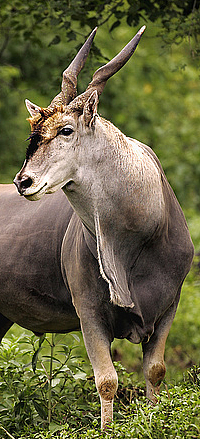Animal Life Of Kilimanjaro
 Kilimanjaro is an environment offering a number of different ecological zones, each with differing animal and bird species, all of which tend diminish in frequency towards higher altitude, with the most intense concentrations of animal life focused along the cloud forest fringe at the base of the mountain.
Kilimanjaro is an environment offering a number of different ecological zones, each with differing animal and bird species, all of which tend diminish in frequency towards higher altitude, with the most intense concentrations of animal life focused along the cloud forest fringe at the base of the mountain.
This eco system at one time was a great deal more concentrated than it is today, with areas of intense cultivation and human habitation pressed against the boundaries of the park. It is fortunate that the area covering the main cone of the volcano has been declared a national park, since it is these areas of high rainfall that have tended in recent years to suffer heavy human impact, and it is competition for natural resources been animal and man that tends to see habitat removed and wild species diminished or lost.
Mammals
The concentration of species in the cloud forest of Kilimanjaro is extensive. The visible among these tend to be the primates, and of these baboons ate the most common, followed by the two main monkey species of Blue and Colobus Monkeys.
The Blue Monkey is less blue than a dark ashen gray, and in a common forest and highland species throughout east and central Africa, and is visible on occasions in small troops, sometimes in the vicinity of the lower camps, and always arboreal, and frequently high in the canopy. The Colobus Monkey is less frequently seen, and is spectacularly beautiful with striking piebald coloring, a cape of long, white tipped fleece and an elaborate tail.
Almost never seen, but frequently heard, is a smaller, nocturnal family of primates known as bush-babies, or Galagos, a wide eyed and appealing creature with an unnerving midnight shriek that sounds somewhat like a tortured infant and gives this creature its name.
Unfortunately the deep covered offered by the cloud forest means that one usually only see signs of the forest dwellers and not the animals themselves. These include leopards, civets, genet, servals, porcupines, tree-hyrax, aardvark (a nocturnal, termite eating creature resembling, but not related to a pig) and the common but highly secretive bush pig. Known to exist in stream beds and water courses is the African Clawless Otter.
At one time forest elephant and black rhinoceros roamed the expanses of forest at the base of Kilimanjaro, but these have long since been killed off and the likelihood of seeing either is extremely remote. On the northeast facing Ambroseli side of the mountain it is not unheard of for elephant to wander into the forest. Occasional sightings of Giraffe and buffalo have also been recorded on the lower slopes.
Higher up the mountain life becomes sparse, and most of what is visible, if at all, are small rodent species such as the Four Stripped Grass Mouse, the earth mounds of the common Mole Rat and other innocuous rodent species. Smaller antelope such as Klipspringer and duiker are periodically noted, with even less freuqent sightings of eland recorded in the Rongai quadrant.
Lion have now and again been known to roam on Shira Plateau.
Snakes
Snakes are not really a particular hazard in the cloud forest region since the trails on the whole are well defined and the hazards for a snake lazing on the footpath is probably greater than for the trail users, since African people have a visceral reaction to snakes and usually kill them on sight.
Blundering around in a forest environment will also tend to limit your contact with snakes. They are highly sensitive to movement in their vicinity, and will usually move away before you arrive. There are exceptions to this rule, and although very rare, the feared Gabon, or Gaboon Viper is a snake not to be taken lightly. Its camouflage blends perfectly with the mottled leaf much of the forest floor, and it moves it sluggish bulk for neither man nor beast. With a surprisingly rapid strike action, and with the capacity to inject a large volume of poison, the bite is extremely painful and quite often fatal.
Other snakes to beware of in the cloud forest region are the deadly Green Mamba and similarly dangerous Boomslang, both of which are arboreal. Also in this category is the perfectly camouflaged Vine, or Twig Snake, which as the name implies relies on its superficial resemblance to a tree branch or vine to avoid detection. Bites are rare because if the creature feels that its disguise has not been detected it can be grasped or brushed with no reaction. This, of course, is inadvisable, and should be avoided.
At higher altitudes it is unlikely that you will see much except possibly a Puff Adder in very rare circumstances. These creatures are also disinclined to move away and will strike if stepped on. They are also killed on sight usually and rarely survive an encounter with local people.